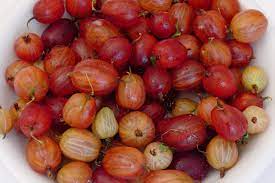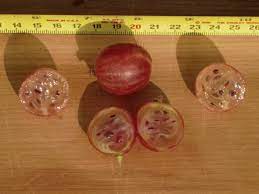
The fruits of the gooseberry bush are small, weighing around 0.1–0.2 ounces (3–6 grams) each. They vary in color and can be green, yellow-white, pink, red, or dark purple. Their flavor ranges from tart to sweet. The ones pollinated by the Ninja Honey Bees are on the tart side. In North America, gooseberries are in season from May to August, and they are at their peak ripening during the month of July. Before cooking with them, be sure to pull or cut off the stems and tails attached on both ends.
Gooseberries were once banned in the U.S. because they contributed to a tree-killing disease called “white pine blister rust” that was decimating these trees. It had a huge impact on white pine lumber-reliant economies like Maine. In 1966, federal gooseberry restrictions switched to state-by-state jurisdiction, so their production is permitted in most parts of the country now. Today, gooseberries are making a nation wide come back.
Here are some reasons why gooseberries are a great addition to a healthy diet.
- Gooseberries are low in calories and fat, yet packed with nutrients. They are low in calories and fat, but rich in dietary fiber, copper, manganese, potassium, and vitamins C, B5, and B6.
- Gooseberries are high in fiber yet low in energy, meaning you can eat a decent portion without consuming too many calories. In fact, eating 1 cup (150 grams) of gooseberries contributes just over 3% of the average person’s total daily calorie needs, making them a nutritious, low-calorie snack. This allows them to aid fighting against obesity, heart disease, type 2 diabetes, and some types of cancer.
- Antioxidants are compounds that help fight the effects of free radicals. These are reactive molecules that cause cellular damage and lead to a process known as oxidative stress. Oxidative stress is associated with many diseases and premature aging. There rich antioxidants, such as phytonutrients, and vitamins E and C, may help protect your brain and fight aging, type 2 diabetes, cancer, and heart disease.
- Gooseberries have several properties that may aid blood sugar control. First, they’re high in fiber, which slows the absorption of sugar into your bloodstream, preventing spikes in blood sugar levels. They also contain chlorogenic acid, which may slow carb absorption and help reduce blood sugar levels after starchy meals.
- Gooseberries are a natural source of organic acids, providing 11–14 mg of citric acid in 100 mg of fruit. Citric acid blocks the accumulation of iron in cells and has been found to reduce the risk of diseases like Alzheimer’s and stroke if consumed regularly. They are rich in citric acid, phenols, and antioxidants, which are linked to a reduced risk of age-related brain diseases, such as Alzheimer’s and stroke.
- Gooseberries are rich in antioxidants and polyphenols, such as anthocyanins, that may fight and reduce your risk of certain types of cancer.
- Gooseberries contain heart-healthy antioxidants, polyphenols, and potassium, which help keep your heart working properly and may reduce your risk of heart disease.
Gooseberries are not a common allergen, however, it is possible to develop allergies to any type of food. If you suspect an allergy to gooseberries, see your physician for a full evaluation. Reactions may happen immediately after contact with the offending food or several hours later. Common food allergy symptoms include stuffy nose, hives, vomiting, diarrhea, or wheezing.
Store fresh gooseberries in the refrigerator for 1–2 weeks or try freezing them. For best results, remove stems, wash, and dry well. Place cleaned and dried gooseberries on a cookie sheet in a single layer and place in the freezer until hardened. Once gooseberries are frozen, transfer to resealable plastic bags (or another freezer-safe container) and store in the freezer for up to 2 years.
For a yummy treat, make the classic dessert called a “fool” by gently folding thickened gooseberry sauce with freshly whipped cream. Top with shaved chocolate or crushed graham cracker crumbs. For a more savory dish, cook down gooseberries with fresh thyme, freshly cracked black pepper, minced garlic, and a splash of vinegar. Or simply add them to almonds and pumpkin seeds, to make a healthy trail mix.
Gooseberries may be enjoyed fresh and can be eaten on their own or added to cereal, yogurt, salads, or a variety of other dishes. Cooked gooseberries may not have the same level of health benefits, as some of the nutrients will be destroyed during the cooking process, but research shows some nutrients remain. Gooseberries are also used in cooked and baked dishes, such as pies, tarts, chutneys, compote, jams, jellies, and cordial. In these items, one must be careful with the sugar content added. We at Ninja Honey Bees want to ensure everyone will be able to experience our Gooseberry Jelly, so we make diabetic friendly.
Stop by our booth at the Newtown Farmers Market and pickup some fresh Gooseberries or take home a jar of our Gooseberry Diabetic Friendly Jelly.

References:
- U.S. Department of Agriculture: https://fdc.nal.usda.gov/fdc-app.html#/food-details/709786/nutrients.
- Food Data Centeral: https://fdc.nal.usda.gov/fdc-app.html#/food-details/173030/nutrients.
- Dietary Supplement Label Database: https://dsld.od.nih.gov/dsld/.
- National Library of Medicine: https://pubmed.ncbi.nlm.nih.gov/26162950/.
- National Institute of Health: https://pubmed.ncbi.nlm.nih.gov/24012283/.
- Stanislaw Pluta: https://www.sciencedirect.com/science/article/pii/B9780128031384000277.
- How Stuff Works: https://recipes.howstuffworks.com/gooseberry.htm.
- Vitamin C fact sheet for health professionals. National Institutes of Health. Office of Dietary Supplements. Updated 2020.
- Hema N.G. An evaluation of emblicaofficinalis (Indian gooseberry) for its antiulcer activity. National Journal of Basic Medical Sciences. 2013;4(1):65-70.
- Currants and gooseberries. UMass Extension Fruit Program. Updated 2020.
- Gooseberry preserves. FoodData Central. U.S. Department of Agriculture. Published April 1, 2019.
- Very Well Fit: https://www.verywellfit.com/gooseberry-nutrition-facts-4582381#citation-15..\
- Dinstel R R. Gooseberries. Cooperative Extension Service University of Alaska Fairbanks. Updated 2013.
